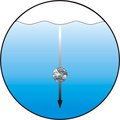Page path:
- Press Office
- Press releases 2008
- The Settling of Porous Particles in Water
The Settling of Porous Particles in Water
The Max Planck Society (MPS) supports a scientific collaboration between the Biogeochemistry Department of the Max Planck Institute for Marine Microbiology in Bremen and the Civil Engineering Department of Massachusetts Institute of Technology (MIT), on studying the `Settling behavior of porous particles in stratified oceans'. The aim of the project is the prediction of the settling times of porous particles and thus their role in carbon export and thin layer formation. The Mathematical Modeling Group of the MPI will perform the modeling part, whereas the experimental studies will be carried out jointly with MIT.
The ecology and biogeochemistry of the ocean are strongly influenced by particle settling, as particles are the main vector of carbon export from the upper ocean towards the ocean floor. The latter mechanics represents a key component of the ocean carbon cycle
Most marine particles are highly porous resulting in peculiar fluid dynamical behavior that influences the settling process considerably, in particular at density interfaces (pycnoclines). At pycnoclines, it is found that the particle settling speed is dramatically reduced. This results in enhanced opportunities for marine microorganisms to attach to particles, as well as in the accumulation of particles and the formation of thin layers. These layers are ubiquitous in the ocean, and are believed to play a significant ecological role, hosting localized ecosystems where abundance and growth of organisms are enhanced.
"Despite the importance of these regions, we are still in the dark as to the underlying fluid mechanics of their formation, for which the settling dynamics of individual particles is a fundamental component", says Prof. Khalili from MPI. In the collaboration project between the Mathematical Modeling Group and MIT, they are going to study mathematically and experimentally the settling behavior of aggregates in a density-stratified ambient.
The project is supported by the Max Planck Society (MPS) for 3 years.
Addendum:
At present, there is an opening for a postdoc student
to work partially at MIT and partially at MPI-Bremen.
Highly qualified experimental physicists or mechanical engineers with excellent experience in non-invasive visualization methods (PIV, PTV, PLIF) are invited to contact
Prof. Arzhang Khalili. akhalilimpi-bremen.de
Most marine particles are highly porous resulting in peculiar fluid dynamical behavior that influences the settling process considerably, in particular at density interfaces (pycnoclines). At pycnoclines, it is found that the particle settling speed is dramatically reduced. This results in enhanced opportunities for marine microorganisms to attach to particles, as well as in the accumulation of particles and the formation of thin layers. These layers are ubiquitous in the ocean, and are believed to play a significant ecological role, hosting localized ecosystems where abundance and growth of organisms are enhanced.
"Despite the importance of these regions, we are still in the dark as to the underlying fluid mechanics of their formation, for which the settling dynamics of individual particles is a fundamental component", says Prof. Khalili from MPI. In the collaboration project between the Mathematical Modeling Group and MIT, they are going to study mathematically and experimentally the settling behavior of aggregates in a density-stratified ambient.
The project is supported by the Max Planck Society (MPS) for 3 years.
Addendum:
At present, there is an opening for a postdoc student
to work partially at MIT and partially at MPI-Bremen.
Highly qualified experimental physicists or mechanical engineers with excellent experience in non-invasive visualization methods (PIV, PTV, PLIF) are invited to contact
Prof. Arzhang Khalili. akhalilimpi-bremen.de


